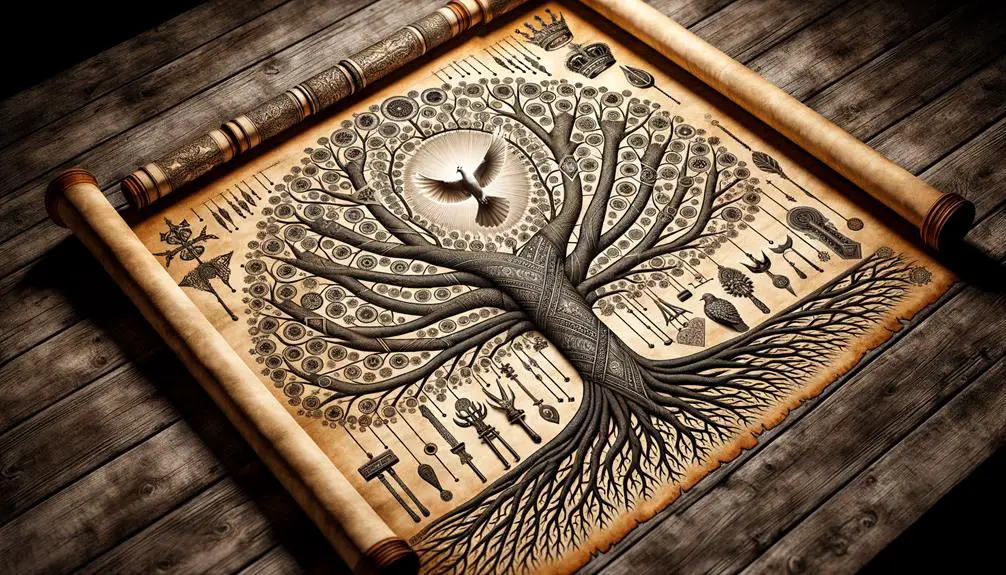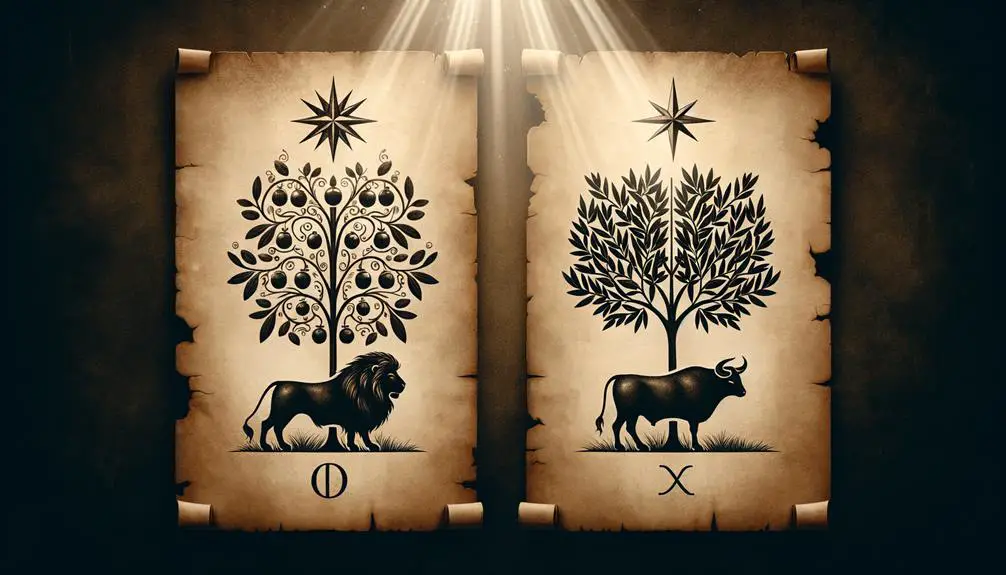Discover the intriguing locations of Jesus' genealogy in the Bible, and why these accounts are pivotal for understanding His unique lineage.

Where Is the Genealogy of Jesus in the Bible
When you open the New Testament, you'll quickly stumble upon the genealogy of Jesus in two places: Matthew 1 and Luke 3. Each account serves a unique purpose, with Matthew tracing Jesus' lineage through Joseph, emphasizing Jesus' legal right to the throne of David, and Luke taking a slightly different route, highlighting Jesus' connection to all of humanity through Mary.
This distinction raises intriguing questions about the historical and theological implications of each genealogy. To fully grasp the significance, let's explore what these differences tell us about the narrative and message the Gospel writers intended to convey.
Key Takeaways
- Jesus' genealogy appears in Matthew 1:1-17, tracing back to Abraham.
- Luke's account extends Jesus' lineage to Adam, found in Luke 3:23-38.
- Matthew emphasizes Jesus' Jewish heritage and royal lineage for a Jewish audience.
- Luke highlights Jesus' universal significance and connection to all humanity, appealing to Gentiles.
Matthew's Genealogical Account

Matthew's genealogical account meticulously traces Jesus's lineage back to Abraham, underscoring the fulfillment of biblical prophecy and establishing a direct line to the founding patriarch of the Israelites. This lineage, as Matthew presents it, isn't merely a list of names; it's a carefully constructed narrative, woven with numerical patterns and pointing to Jesus's royal lineage.
You'll find that Matthew divides the genealogy into three distinct sets of fourteen generations. This numerical pattern isn't arbitrary. In Hebrew, the letters of David's name add up to fourteen, suggesting that Matthew is highlighting Jesus's connection to King David, and thus, his rightful place in the royal lineage. This structure serves a dual purpose: it reinforces Jesus's messianic qualifications and aids in memorization, a crucial feature in a predominantly oral culture.
Furthermore, Matthew's inclusion of four women—Tamar, Rahab, Ruth, and Bathsheba (referred to as 'Uriah's wife')—in the genealogy is significant. These women, each associated with unconventional or scandalous stories within the context of Hebrew society, underscore God's grace and the inclusive nature of Jesus's mission. This aspect of the genealogy breaks from traditional expectations and emphasizes that Jesus's kingship is unlike any other, characterized by grace and open to all, regardless of their past.
In delving into Matthew's account, you're not just encountering a list of names. You're engaging with a carefully crafted narrative that asserts Jesus's legitimacy as the Messiah, through both his royal lineage and the fulfillment of Old Testament prophecies, all while emphasizing the transformative power of grace.
Interpreting Matthew's Lineage
When we delve into the lineage presented by Matthew, it's imperative to recognize the intricate narrative structure and symbolic significance embedded within this genealogical account. Matthew meticulously constructs Jesus' genealogy to highlight the Davidic lineage, underscoring Jesus as the rightful heir to David's throne. This emphasis isn't merely historical but deeply theological, aiming to establish Jesus' identity as the prophesied Messiah.
Your understanding of this lineage must account for its division into three sets of fourteen generations. This structuring is deliberate, serving not just as a mnemonic device but also as a symbolic gesture. The number fourteen, being numerically linked to David through the Hebrew numerical value of his name, reinforces Jesus' connection to David and, by extension, his claim to messianic kingship.
Moreover, Matthew's inclusion of women—Tamar, Rahab, Ruth, and Bathsheba—each with complex stories, further enriches the narrative. This is unusual in ancient genealogies and signifies a broader inclusivity and a break from traditional expectations. It points to the universality of Jesus' mission and the overturning of societal norms.
Analyzing Matthew's genealogical account, you're invited to see beyond a mere list of names. It's a carefully crafted narrative aimed at establishing Jesus' messianic credentials through the Davidic lineage and prophetic fulfillment. This lineage isn't just a record; it's a theological statement, proclaiming Jesus as the culmination of Jewish hope and expectation, intricately woven into the fabric of Matthew's Gospel narrative.
Luke's Genealogical Perspective

Turning our attention to Luke's Gospel, we encounter a genealogical account that, while echoing the Davidic connection, presents a markedly different path to illuminate Jesus' universal significance. Unlike Matthew, who meticulously arranges Jesus' lineage to affirm His Jewish heritage and rightful claim to the throne of David, Luke's approach serves a broader purpose, emphasizing Jesus as the Savior for all humanity, including Gentiles.
- Gentile Inclusion: Luke's genealogy notably extends beyond Abraham to Adam, symbolizing Jesus' connection not just to the Jewish people but to all of humanity. This inclusivity underscores the universal scope of Jesus' mission.
- Literary Structure: The genealogy in Luke is strategically placed between the baptism of Jesus and His temptation, framing it within the context of His divine sonship and forthcoming ministry, rather than his kingly heritage.
- Reverse Order: Unlike traditional genealogies, Luke lists Jesus' ancestors in reverse, beginning with Jesus and tracing back to Adam. This method highlights the progression from the human to the divine.
- Emphasis on the Holy Spirit: Luke's narrative frequently underscores the role of the Holy Spirit, aligning the genealogy within a framework of divine action and guidance.
- Adam as 'Son of God': By concluding the genealogy with Adam, termed as the 'Son of God,' Luke draws a parallel between Jesus and Adam, reinforcing the theme of Jesus as the second Adam who comes to redeem the fall of the first.
Luke's genealogical perspective, rich in symbolism and intent, weaves a narrative that elevates the significance of Jesus' ancestry beyond mere lineage, presenting Him as the Savior for all, irrespective of heritage.
Analyzing Luke's Ancestry List
Delving into Luke's ancestry list reveals a meticulously crafted lineage that, through its unique reverse order and inclusive range, underscores Jesus' role as a universal savior, transcending cultural and historical boundaries. Luke's account, starting with Jesus and tracing back to Adam, not only anchors Jesus within the fabric of human history but also elevates his connection to all humanity, regardless of their cultural or historical background.
This detailed examination is pivotal for understanding the broader implications of Jesus' lineage in terms of historical accuracy and cultural context. Luke's approach, by emphasizing a direct line through David's son Nathan instead of Solomon, presents an alternative view that complements the traditional Judaic royal lineage with a more inclusive one. This inclusivity is not just a theological statement but a profound acknowledgment of Jesus' universal appeal and mission.
Character |
Emotional Impact |
|---|---|
Adam |
Connection to all humanity, evoking a sense of unity and origin. |
Abraham |
Reminds of the promise and covenant, eliciting hope and faith. |
David |
Symbolizes royal lineage and fulfillment, stirring respect and anticipation. |
Nathan |
Highlights an alternate path, inspiring contemplation and acceptance. |
Jesus |
Culminates the lineage, evoking awe, reverence, and love. |
Through this lineage, Luke intricately weaves Jesus into the tapestry of human history, emphasizing his role not just within a specific cultural context but as a figure of universal significance. This scholarly analysis of Luke's genealogy list, with its attention to historical accuracy and cultural context, enriches our understanding of the text and its enduring impact on readers across generations.
Comparing Matthew and Luke

In examining the genealogies of Jesus as presented by Matthew and Luke, one immediately notices significant differences and unique perspectives that each account brings to the understanding of Jesus' lineage. Diving deeper into these accounts reveals how historical context and source differences shape each narrative, offering a complex picture of Jesus' ancestry.
- Direction of Ancestry: Matthew traces Jesus' lineage from Abraham down to Jesus, emphasizing Jesus' Jewish heritage and role as the promised Messiah. Luke, conversely, works from Jesus back to Adam, highlighting Jesus' universal significance for all humanity.
- Key Figures: Matthew includes figures like David and Abraham, pivotal to Jewish identity, while Luke's list extends to Adam, underscoring the universal nature of Jesus' mission.
- Purpose and Audience: Matthew's account targets a Jewish audience, seeking to establish Jesus' legal right to the throne of David. Luke's narrative, aimed at a Gentile audience, stresses Jesus' connection to all people.
- Number of Generations: Matthew meticulously organizes Jesus' genealogy into three sets of fourteen generations, which may symbolize historical completeness. Luke presents a more extensive list, which may aim for a comprehensive theological message rather than historical accuracy.
- Source Differences: Scholars suggest Matthew and Luke drew from different sources for their genealogies, reflecting the diverse traditions and oral histories within early Christianity.
These distinctions between Matthew and Luke's genealogies offer insights into their respective theological intentions and the historical context in which they were written. The differences underscore the multifaceted nature of interpreting sacred texts, revealing the depth and complexity inherent in biblical genealogies.
Frequently Asked Questions
How Does the Genealogy of Jesus Support or Challenge the Concept of the Messiah in Jewish Tradition?
You'll find that Jesus' genealogy, as listed in the Gospels, supports the concept of the Messiah in Jewish tradition by aligning with Messianic prophecies. Specifically, it confirms His Davidic lineage, a critical criterion for the Messiah.
This connection not only bolsters the claim of Jesus as the prophesied Messiah but also challenges any skepticism by fulfilling the longstanding expectation of a savior descending from King David's line.
Are There Any Notable Omissions or Additions in Jesus' Genealogy That Have Theological Implications?
Yes, in analyzing Jesus' genealogy, you'll notice significant omissions and additions bearing deep theological implications. These deviations aren't random; they're imbued with genealogical symbolism, shedding light on broader themes like redemption and divine intervention.
A notable feature is the matrilineal emphasis, unusual in historical contexts, highlighting women's pivotal roles in salvation history. This focus challenges conventional norms and underscores a more inclusive understanding of divine lineage.
How Do Non-Canonical Texts or Apocryphal Gospels Treat Jesus' Genealogy, and How Does This Compare to the Canonical Accounts?
As they say, 'Truth is stranger than fiction,' and this rings true when comparing non-canonical texts with canonical accounts of Jesus' genealogy. Gnostic perspectives often offer alternative narratives, challenging textual reliability and established beliefs.
These apocryphal gospels diverge significantly, presenting a rich tapestry of interpretations that scholars dissect meticulously. Analyzing these texts reveals not just theological implications but also sheds light on early Christian diversity and thought.
In What Ways Have Different Christian Denominations Interpreted the Differences in Genealogical Accounts Between Matthew and Luke?
You'll find that Christian denominations interpret the differences in Matthew and Luke's genealogical accounts uniquely. Some view Luke's version as Jesus' maternal lineage, while Matthew presents the paternal line, emphasizing Joseph's legal fatherhood.
Others lean on adoption theories, suggesting Luke showcases Joseph's ancestry through adoption or Levirate marriage. This analytical dive into scripture reflects a rich scholarly debate, underscoring the complexity of biblical genealogy and its theological implications.
How Have Historical and Archaeological Findings Impacted Our Understanding of Jesus' Genealogy as Presented in the Bible?
You've probably wondered how historical and archaeological findings have reshaped our understanding of Jesus' genealogy.
These discoveries have critically influenced genealogical methodologies, shedding light on family lineage controversies.
By analyzing artifacts and historical texts, scholars have been able to provide a more nuanced interpretation of biblical accounts.
This approach has bridged gaps in our knowledge, offering a clearer picture of the historical context surrounding Jesus' ancestry.
Conclusion
In your journey through Matthew and Luke's genealogies, you've navigated distinct lineages tracing Jesus's roots. Despite initial skepticism over discrepancies, a closer examination reveals the depth of these accounts, highlighting varied theological emphases and ancestral perspectives.
This comparative analysis not only enriches your understanding of the Gospel narratives but also underscores the complexity of biblical genealogies. Embrace these differences; they're not contradictions but rather complementary layers adding to the multifaceted portrait of Jesus's heritage.



Sign up